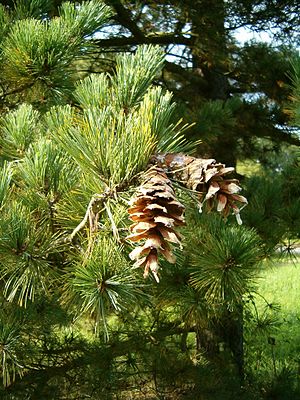Rumelian pine
| Rumelian pine | ||||||||||||
|---|---|---|---|---|---|---|---|---|---|---|---|---|

Rumelian pine ( Pinus peuce ) |
||||||||||||
| Systematics | ||||||||||||
|
||||||||||||
| Scientific name | ||||||||||||
| Pinus peuce | ||||||||||||
| Griseb. |
The Rumelian pine ( Pinus peuce ), also called Macedonia pine , Macedonian pine or Balkan pine , is a plant species in the genus pine ( Pinus ). It is an endemic species of conifer in the mountains of the southern Balkan Peninsula with the natural distribution in the Prokletije and parts of North Macedonia , Bulgaria and Greece . In German , the Rumelian pine is named after the geographical name Rumelien , with which the European part of the Ottoman Empire was designated.
General
In its natural range, the Rumelian pine grows in loose, pure stands or socialises in the high-montane and subalpine vegetation level at heights between 800 and 2200 m and occurs up to the upper tree line. It is a light tree species and prefers moderately nutrient-rich and medium to deep silicate or serpentine soils , but also thrives on subsoil rich in calcium carbonate .
Today the Rumelian pine is an important forest tree on the Balkan Peninsula and is also grown in the lowlands. Its distribution as an economic tree species is insignificant in the forests of Central Europe, but it is cultivated more frequently in Scandinavia .
The Rumelian pine is only slightly susceptible to the bladder rust fungus Cronartium ribicola , which can cause bark bladder rust disease (stubble rust) in five-needle pine species.
description
Habitus
The Rumelian pine rarely reaches heights of more than 15 m in higher mountain areas. In lower regions it can reach heights of up to 30 m. It is fast-growing and, like the Swiss stone pine , has a conical shape. The Rumelian pine is branched down to the ground. The branches are short, thick and bare, young shoots are greenish, bare and shiny.
Needles
The gray-green needles of the Rumelian pine sit in groups of five on a short shoot. They are about 7 to 10 cm long and stiff. The needles are not pendulous, which distinguishes the Rumelian pine from the closely related lacrimal pine . They have a triangular cross-section, are pointed and the needle edges are finely sawn. There is a gap opening on each needle side . The needles usually stay on the tree for two to three years
Buds
The buds of the Rumelian pine are 5 to 10 mm long, narrowly egg-shaped, tapering to a point and resinified .
Flowers and cones
The Rumelian pine is single-sexed . It blooms in May and June. The male flowers are spike-shaped around the base of the youngest long shoots . They are about 1 cm long, cylindrical and yellow to slightly reddish in color.
The female cones are small and yellowish-reddish. They often stand alone.
Cones and seeds
The cones of the Rumelian pine are 8 to 12 cm long and have a very short stalk. They are protruding to the side or hanging. The longitudinally grooved scales are wide and relatively long. The “signs” only protrude a little and are somewhat thickened. They ripen in October, 17 to 18 months after pollination. In contrast to the cone scales of the Weymouth pine , the scales of the ripe cones of the Rumelian pine are slightly inwardly curved at the tip. The 7 to 8 mm large seeds are each equipped with a 14 to 22 mm long wing ( rotary flyer ). Often they are spread by birds.
Chromosome number
The number of chromosomes is 2n = 24.
bark
The bark of the Rumelian pine is smooth and silver-gray when young. In older trees, it is darker and rough. Later it becomes flaky, cracked and flaky.
Systematics
The Rumelian pine is assigned to the sub-genus Strobus (Haploxylon), the section Quinquefoliae and the subsection Strobus within the genus of the pines ( Pinus ) . The first description of the species as Pinus peuce was made in 1846 by the German botanist August Heinrich Rudolf Grisebach in his work "Spicilegium florae rumelicae et bithynicae .." Volume 2, page 349th
Individual evidence
- ↑ a b c d e f g h i j k M. G. Eiselt, R. Schröder: Coniferous trees . Neumann Verlag, Radebeul 1974, p. 199 .
- ^ A b Ivanka Stevanova, Klaus Oeggl : On the Holocene vegetation history of SW Bulgaria: The Praso moor in the Pirin Mountains. In: Reports of the scientific-medical association in Innsbruck. Volume 80, 1993, pp. 69-80. (pdf; 1.70 MB)
- ↑ a b c d e f g h i j R. Erlbeck, IE Haseder, GKF Stinglwagner: Das Kosmos Wald- und Forstlexikon . Franckh-Kosmos Verlag, Stuttgart 2002, ISBN 3-440-09316-6 , p. 414 .
- ↑ a b c d e www.conifers.org - Pinus peuce
- ↑ a b c G. Krüssmann: The conifers . Verlag Paul Parey, Berlin / Hamburg 1979, ISBN 3-489-60222-6 , p. 199 .
- ^ Tropicos. tropicos.org
- ^ Robert Zander (Enke / Buchheim / Seybold): Concise dictionary of plant names. 12th edition. Deutscher Landwirtschaftsverlag Berlin, undated (1981), DNB 830795677 . (corresponds to Eugen Ulmer, Stuttgart 1980, ISBN 3-8001-5017-4 )
- ↑ Rafaël Govaerts (ed.): Pinus. In: World Checklist of Selected Plant Families (WCSP) - The Board of Trustees of the Royal Botanic Gardens, Kew . Retrieved April 25, 2019.
Web links
- Thomas Meyer: Data sheet with identification key and photos at Flora-de: Flora von Deutschland (old name of the website: Flowers in Swabia )
- Pinus peuce inthe IUCN 2013 Red List of Threatened Species . Posted by: Farjon, A., 2011. Retrieved November 28, 2013.

